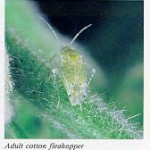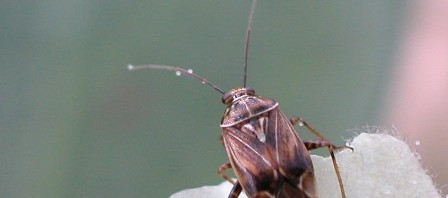Many scouts and consultants are reporting declining square retention even when no or below threshold numbers of plant bugs are detected. Reports of malformed squares (extra bracts and extruding reproductive structures, see picture below) are being reported from many fields. Continue reading
All posts by Scott Stewart, West TN Research & Education Center
Soybean Insect Update
There have been several more reports of threecornered alfalfa hopper (TCAH) infestations in seedling soybean where a high percentage of plants have been girdled. Plants less than 10 inches tall are susceptible to girdling. The girdling will not directly cause yield loss unless plants lodge. Lodging often occurs later in the season and especially where stands are thin. Please refer to my previous blog article about TCAH. Continue reading
Cotton IPM Update – Plant Bugs and Stink Bugs
I’ve made a number of comments about controlling plant bugs on pre-flowering cotton in previous blog articles (linked below). Tarnished plant bug infestations continue to remain above average in many fields. Rain is aggravating the spray logistics and Continue reading
Early Cotton Growth and Heat Units
Over the weekend (6/25-6/26) cotton planted on April 11 began to bloom. Generally 850 heat units are required to produce a bloom. Continue reading
Would You Know a Cotton Fleahopper if You Saw One?
I’ve had a couple of reports of cotton fleahoppers, and this pest has also been observed in our neighboring states. The cotton fleahopper is a green colored plant bug (see picture below). The adults are about one-half the size of tarnished plant bugs. The immatures are smaller, lack wings and light green in color. They can cause the shedding of small squares similar to tarnished plant bug.

I dealt with fleahoppers when I lived in Texas where they use a treatment threshold that ranges anywhere from 10-25 bugs per 100 terminals during the first three weeks of squaring. In my experience, 20-25 fleahoppers per 100 terminals is often enough to reduce square retention below acceptable levels. The good news is that cotton fleahopper infestations should be controlled by the typical rates of Carbine, Centric, Intruder and imidacloprid recommended for tarnished plant bug.
Cotton Plant Growth Regulators
Plant Growth Regulators
Mepiquat choloride (Pix) plant growth regulator benefits cotton production in the management of boll rot and excessive vegetative growth. The use of mepiquat chloride may result in one or more of the following: height reduction, shorter limbs, more open canopy, better boll retention, less boll rot, improved defoliation and a darker green leaf color. Continue reading

More on Plant Bugs as the Action Continues
 Reports continue of well-above treatment levels of tarnished plant bugs in cotton, especially in fields with 8-10 nodes. There have also been reports of necessary re-treatments. Remember, the suggested treatment threshold for tarnished plant bugs during the first two weeks of squaring is an average of 8 or more bugs per 100 sweeps. You should strive to maintain square retention above 80% by the time you hit bloom. If your square retention is Continue reading
Reports continue of well-above treatment levels of tarnished plant bugs in cotton, especially in fields with 8-10 nodes. There have also been reports of necessary re-treatments. Remember, the suggested treatment threshold for tarnished plant bugs during the first two weeks of squaring is an average of 8 or more bugs per 100 sweeps. You should strive to maintain square retention above 80% by the time you hit bloom. If your square retention is Continue reading
Add UT Crops News Blog to Your Smartphone or iPad Home Screen
To add a bookmark shortcut for UTcrops.com/news to your home screen follow these instructions. Continue reading
